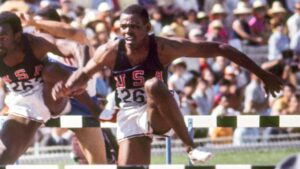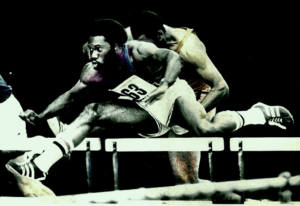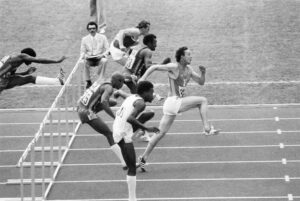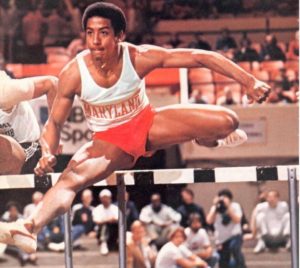Could Back-in-the-Day Hurdlers Compete with Today’s Hurdlers?
by Steve McGill
I was talking to my two older brothers recently about something that has been bothering me for quite a while. As NBA fans, we noticed that the disrespect for previous generations of NBA players seems to be increasing dramatically. It’s gotten to the point where there’s an “I’m done with the 90’s” campaign that disparages the great Michael Jordan. Seriously? Prior to that, we heard experts like recently retired players J.J. Redick and Gilbert Arenas laughing at the idea that players from the 1960s and 1970s could compete with modern-day players. Redick referred to players from the 1960s as “plumbers” and “firemen,” sarcastically referencing the fact, as Jerry West later explained, that players back then didn’t make enough money to rely solely on their basketball income and had to find part-time jobs in the summers.
I was thinking to myself how that level of disrespect doesn’t generally appear in other major sports. You don’t hear current Major League Baseball players saying that Ted Williams was trash, that Mickey Mantle would’ve been a .200 hitter in today’s game, that Tom Seaver or Bob Gibson would’ve won 5 games a year in today’s game. In the National Football League, you don’t hear current players saying that Gale Sayers or Jim Brown were too slow to succeed in today’s game, or that Joe Montana was garbage compared to today’s quarterbacks. In those sports, the greats of the past are not only respected for their greatness, but are honored and remain revered. This is true in spite of the fact that those sports have changed dramatically from past decades, the same as professional basketball.

1968 Olympic champion Willie Davenport
Now, let’s go ahead and apply this question to the hurdles. Could hurdlers from previous decades compete with today’s hurdlers? Let’s focus this conversation on the men’s 110 meter high hurdles. If we’re looking strictly at times, there’s no question that today’s hurdlers are superior to hurdlers of past decades. At the most recent Olympic Games, in 2021, Hansle Parchment won in 13.04, and Grant Holloway was second in 13.09. The top five finishers were under 13.20, and the 8th-place finisher ran 13.38. That 8th-place time matched the first place time of the 1968 Olympics, won by Willie Davenport. Rodney Milburn’s winning time of 13.24 in the 1972 Olympics would’ve put him 7th in 2021. Guy Drut’s winning time of 13.30 in the 1976 Olympics would’ve put him 8th in 2021.

1972 Olympic champion Rodney Milburn
No one would question that Davenport, Milburn, and Drut are all legends of the 110 hurdles. But going by the above numbers, they would get smoked in today’s competitive climate. The winning NCAA time last week was 13.18, and second place was 13.20. Those times would’ve been mind-blowing in the 1960s and 70s, but barely cause a raised eyebrow today. The only hurdler from those old school days whose times would be competitive today is Renaldo Nehemiah. Not only did he run 12.93 in 1981, but he also ran several sub-13.10s. Nehemiah’s 12.93, which was earth-shattering at the time, now is longer even a top-ten fastest race in history, as it ranks only thirteenth.
Again, looking strictly at times, you could say that the 2000s and the 2010s were a golden era in the 110 hurdles. Aries Merritt, David Oliver, Dayron Robles, Liu Xiang, and others competed against each other often, and all of them have times in the top ten, with Merritt at the top with his 12.80. In the current decade, only Grant Holloway has a time that’s in the top ten (12.81). So, are today’s hurdlers really all that much faster than hurdlers back in the day? Allen Johnson’s personal best of 12.92 does not put him in the top ten, but to this day nobody has run as many sub-13’s as Johnson. The winning times at most meets these days aren’t any faster than they were ten or even twenty years ago. So, let’s look beyond times, and consider some other factors.

1976 Olympic champion Guy Drut
Probably the most important factor to consider is that of the track surface itself. Back in the days of Davenport and Milburn, rubber surfaces were a rare thing. Milburn ran on a grass track in high school, and most tracks back then were cinder tracks. If you have no memory of cinder tracks, then believe me when I tell you that they were not conducive to fast times. Even the fastest rubber tracks back then were no better than an average high school track today. There were no polyurethane tracks, no mondo tracks, none of that stuff. Today’s tracks are designed to produce fast times. So I would argue that just based on track surface alone, Milburn’s 13.24 would at least be a 13.04 on mondo or a similar surface.
Then there are the hurdles themselves. Hurdles back in the day were wooden. And heavy. You did not want to hit hurdles back then. If you hit one with an ankle or a knee, that ankle or knee would swell instantly, and you might have some splinters in your skin. That meant that hurdlers generally jumped higher to avoid contact. With today’s hurdles, made of plastic, there’s no fear. You can make significant contact and run right through them without barely losing any speed.
Then there’s shoe wear, which is a big part of the argument when it comes to basketball too. I don’t think Kyrie Irving could do all those fancy moves he does if he was playing in Chuck Taylors like the players in the 1960s. Similarly, the spikes that athletes wore decades ago would barely be serviceable in training, much less races. Now you got these Nike superfly’s and whatnot that make you faster by themselves.

Renaldo Nehemiah, considered by many to be the greatest hurdler ever.
A major factor to consider is technique, and that’s where you can say that today’s hurdlers are far advanced compared to hurdlers in the 1980’s and earlier. Even the great Nehemiah wasn’t as efficient technically as today’s hurdlers. He said himself that if he had known to shuffle between the hurdles like guys do now, he would’ve had a lot more control between the hurdles. Even though I grew up admiring and even worshiping Nehemiah, I can see elements of his technique that I would want to correct were I coaching him. I feel like his upright style caused him to hit hurdles with his trail more so than if he had more of a forward lean in his running and hurdling posture. Davenport’s arms were often wide. Milburn did a lot of experimenting with his arm action. Guy was very efficient but his trail leg was delayed, which is something I don’t teach, and that you don’t see in the best hurdlers of today.
I feel that the major advancements in technique can be credited to two athletes in particular: Allen Johnson and Liu Xiang. Modern hurdlers are, for the most part, descendants of AJ and/or Liu in terms of how they negotiate the barriers. Merritt has his share of disciples too, but he’s the only one I know of who actually mastered that arm style that he used. Johnson was the one I first noticed to keep the lead leg slightly bent throughout hurdle clearance. Prior to AJ, everybody was straight-legging at some point in hurdle clearance. Johnson had more of a cycle action, which has become much more common today. Liu, meanwhile, was super-efficient with his lead arm action, and in terms of getting up and down and running off the hurdle. Dudes like Dayron Robles, Colin Jackon, and now Holloway also deserve credit for advancing the event in regards to how hurdlers hurdle. There are many hurdlers today who are relative no-names who are far more advanced technically than legends of the past.
But that leads to my final point: the hurdlers of today are better than hurdlers from back in the day because of the hurdlers from back in the day. They laid the groundwork, they built the foundation. They and their coaches had to do a lot of experimenting, trial-and-error style, so that a template could be developed. Sometimes the only way you can find out what does work is by finding out what doesn’t, like Milburn with the double-armed action, like Nehemiah zigzagging in the lane in an attempt to create more space. Their experimentations led to later revelations and breakthroughs. Their explorations advanced the event as a whole, even if those explorations didn’t always benefit them directly.
That’s why it’s always important to respect and appreciate the greats of the past. We wouldn’t be where we are today without them.
